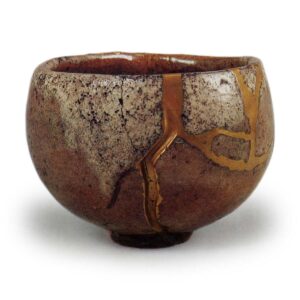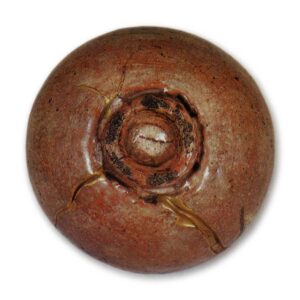

Important Cultural Property
Height 9.5cm, Bore 10.5-11.4cm, Base 4.1cm in diameter
Hatakeyama Memorial Museum
The two characters “Seppou” (Seppou) are written in gold powder on the front of the lid of the tame-nuri inner box in the style of Koetsu, and the brush strokes are in the style of Koetsu, so the box is said to have been made by Koetsu. Originally in the collection of the Mii family, it later passed to the Sakai family, lords of Himeji Castle, but after World War II it was transferred to Issei Hatakeyama, and is now in the possession of the Hatakeyama Memorial Museum.
The round body has a strong tension, giving it a unique shape that is unparalleled. The entire body is molded rather thickly, and the mouth rim is also thick and rounded, with a spatula-shaped part of the rim. The small circular base is slightly high, and the inside of the base is deeply cut down, and it is not clear whether the edge of the base was intentionally cut down or whether it was hollowed out during firing, but there are large grooves like cracks around the kiln and three large and small vertical cracks from the edge of the base to the body, and it seems that there are also defects from the mouth to the center of the body, all of which have been repaired with gold powder lacquer. The body was also damaged from the mouth to the center of the body, all of which were repaired with gold-painted lacquer.
The inscription of “Yukimine” is in reference to the white yuzu (citron) color that was applied like an avalanche from the mouth to the body on one side, while the other side is a slightly astringent ripe persimmon color with uneven white yuzu as if it were dew. There is a white glaze pool in the base, and five uneven marks on the tatami mat. The center of the bowl is slightly raised. This is the work of a person who is playing with the boundaries of imperfection.



